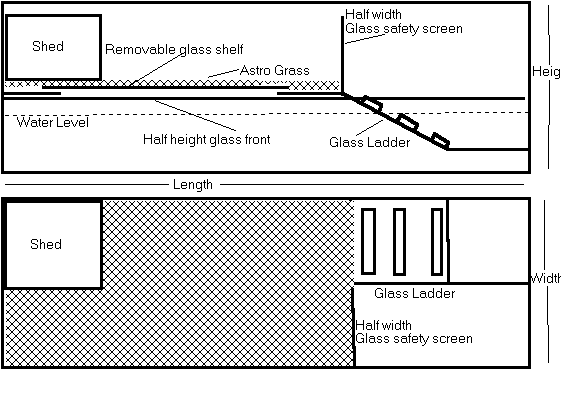
I keep eight asian species, amongst whom are the Leaf turtle Cyclemys dentata, and its bigger brother Heosemys grandis. For more specific information, I have refered to two text books:
"Encyclopedia of Turtles" (Dr. Peter C. H. Pritchard)
"Turtles of Thailand" (Wirot Nutaphand)
Cyclemys Dentata, the Leaf turtle, or the "Tao Daeng" (Brown stream terrapin) comes from Southern Thailand, Burma, Malaysia and the Philippines. It usually has a mid or reddish brown carapace, serrated towards the rear, a paler plastron (with darker markings on the scutes), brown body scales, with grey skin. They grow to about 9-10" when fully adult, and at that stage, a hinge is developed, allowing protected retraction of the head and limbs. As youngsters, these turtles are fairly aquatic, and will feed both in the water, and on land. As they progress towards maturity, a more terrestrial lifestyle is followed (as clearly indicated by the development of the hinge).
Sexual maturity is reached between the ages of 7 and 10. Egg laying takes place several times a year, and reported clutch size is either 2-4 eggs, or 10-20! (I suspect the former, although the large size of the adults indicates that the latter is quite possible). Mating behaviour has not been reported for this species, although I suspect that, as with my own animals, courtship and copulation will be carried out vigorously in water, on land, or even half way up a tree!
Requirements in captivity:
a) Habitat: Commonly about 4-6" in length (this is a common import size for this species). They should be kept in a mixed area, containing sufficient water for "run along the bottom" bathing, combined with a large shelf area and hideaway shed. (Often, the time of day/night will dictate which they prefer). Filtration, provided by a pump and mechanical filter is a must, as clean running water is required if they are to use it at all. The setup I use may be of interest to you: The PVC Mk II Asian Tank. Description: A normal aquarium turned on its side, with a new half height glass front face fitted. The remaining front gap is filled with two sliding rigid wire mesh doors. A removable glass shelf is fitted, taking up two thirds of the tank surface area. A fixed glass ramp connects the shelf to the bottom of the tank. Astro turf (the coarse kind) is provided for grip, and a wooden shed for privacy. The dimensions should be based on the turtles (number and sizes). The height of the removable shelf should be no less than 50% more than the width of the biggest specimen. The tank width should be a minimum of 12" for small specimens, and up to 24" for animals of 6" and over. The length is variable, depending on numbers. I keep 5-7 medium sized turtles in a 48" by 24" tank.
This design (which could be purpose built), combines maximum water and land areas into the minimum space. It allows for feeding on land, or in the water, and takes into account the changing water/ land priorities of asian species.

b) Equipment. Asians love heat, fresh water, and plenty of light. Their tank should be well filtered, or the water changed very regularly. A light should be provided (a Gro-Lux or 60w light bulb is enough). The air temperature should not fall below 700C, and the water temperature below 750C. (a water heater-thermostat is essential).
c) Feeding. All asian turtles are omnivorous, and should be fed a mixture of vegtables, fruit and meat. I feed greens mixed with cat meat (Choosy) on a plate placed on the land. (the astro shelf). For the shy, or young specimen, I supplement this with a meat preparation (fish and catmeat) put into the water, or fed by hand. It is essential to provide vitamins and calcium additives to all food. I use "Nutrobal" for the vitamins,(available from good reptile shops) and "Limestone Flour" (from farming/ horse supply stores) for the calcium.
d) Breeding. The large size of the adults requires dedication and space to encourage regular, natural breeding. They will require large land area to move around in, a heated and lit damp earth/sand tray (at least 6" deep, by 12" square), a bathing tray, and a warm shed. This could be done on the floor of a heated room, but more properly would require a greenhouse(summertime only) or a tropical house. Egg laying will take place regularly throughout the warmer, sunnier months of the year, but unlike tortoises, the secretive, few eggs, many baskets approach of the average asian turtle does make things difficult. (i.e. they are likely to use the earth for burying themselves, as well as eggs, and because of the "often is best" approach, the earth cannot be provided just at laying time).
e) Longevity. I have just been given a Mauremys Japonica (a rare Japanese /asian turtle) by an old gentleman who cannot look after it any more because of ill health. He aquired it in 1947. It is in the peak of health, and clearly looking forward to life in the 21st century! If you have managed to keep a specimen for 3 years, it will be with you forever (PVC observation number one!). Leaf turtles grow big, and so you must plan for the future. (Our turtles and tortoises chose our current house). These animals really are "pets for life"- but beware, this hobby is addictive!
Paul Coleman